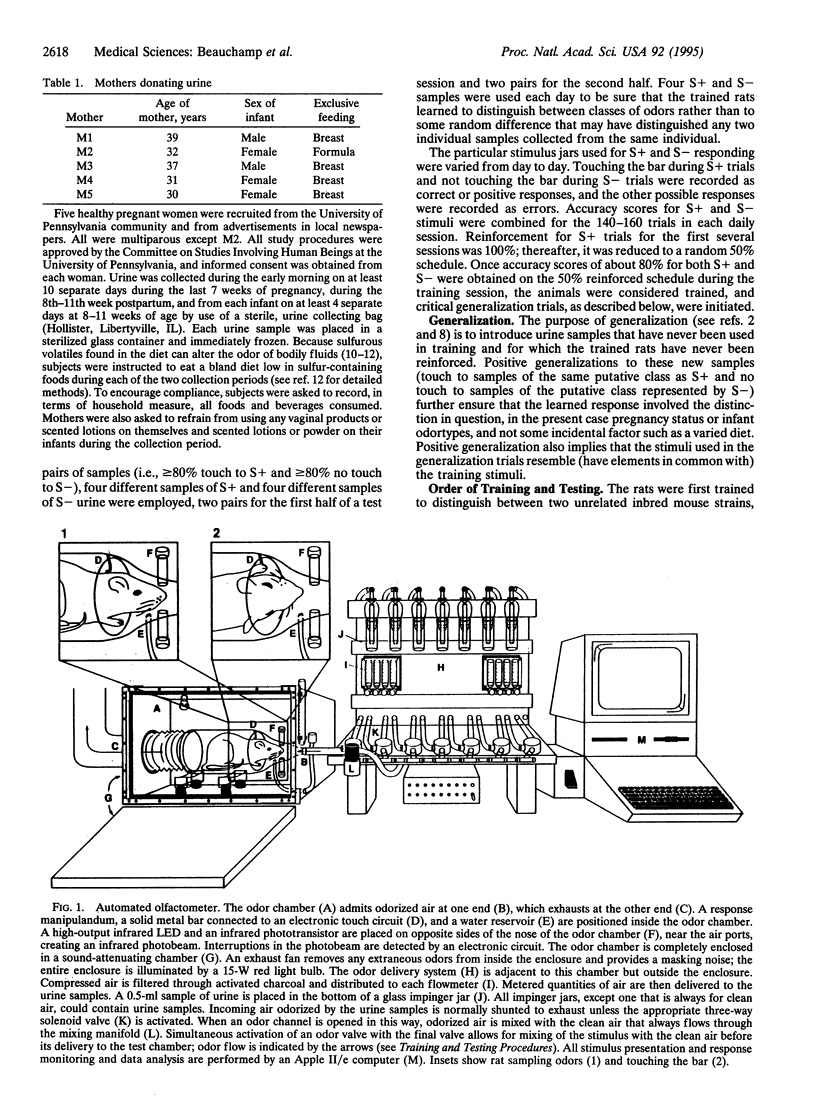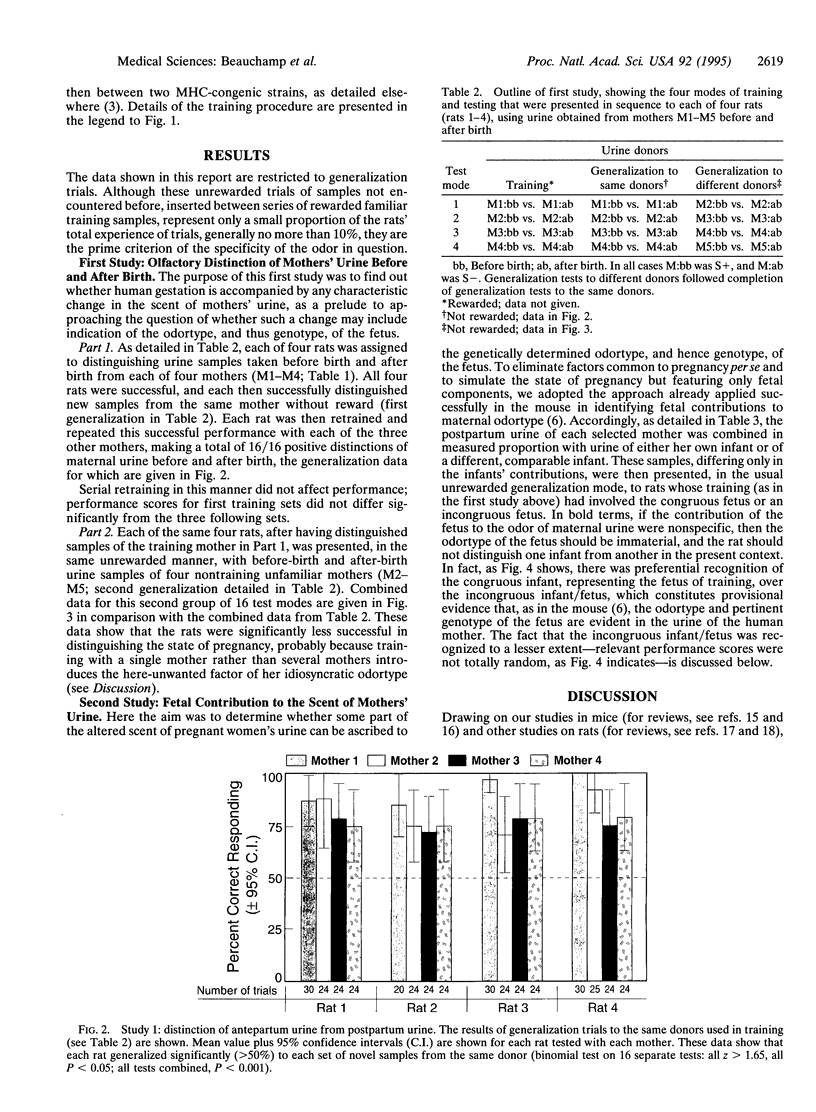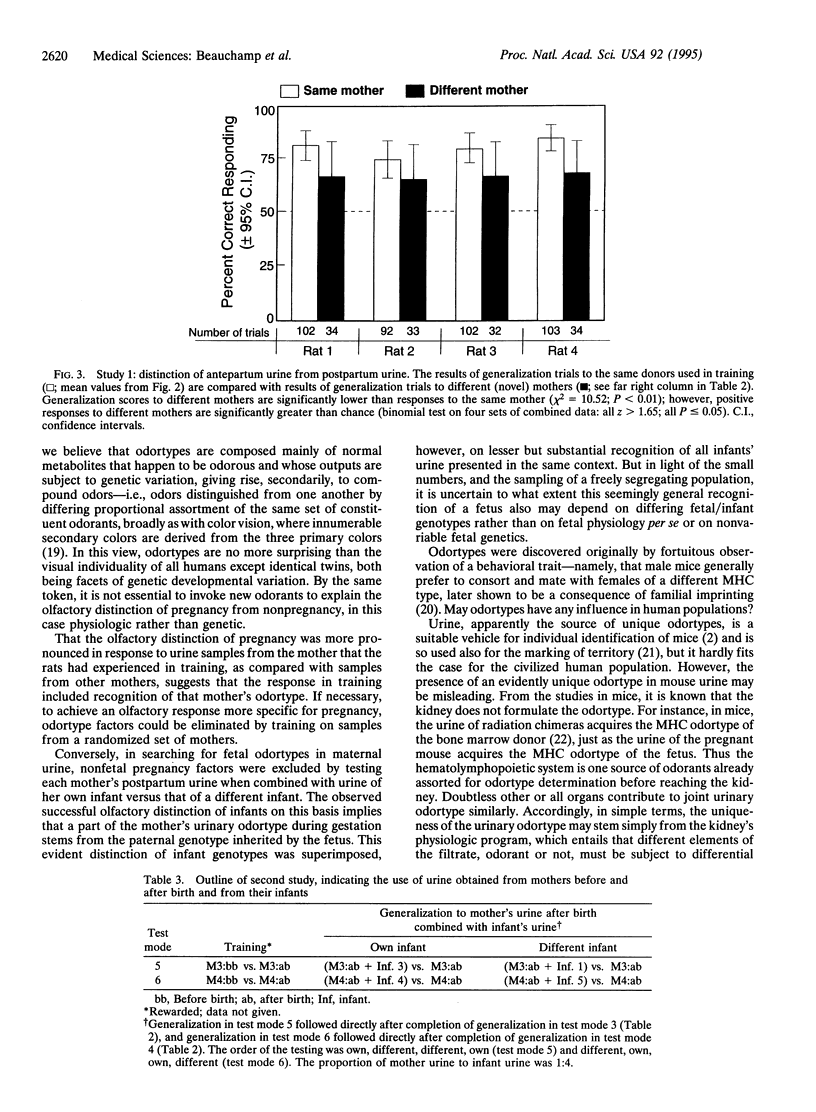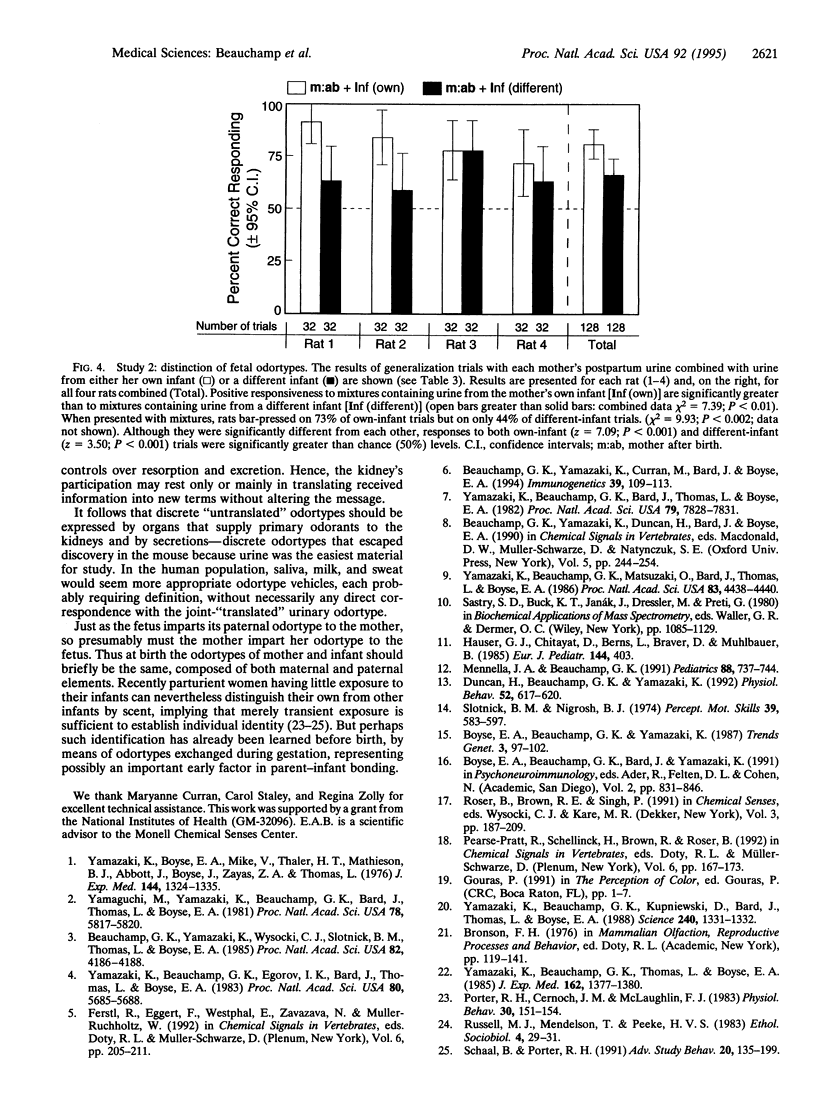Abstract
Odortypes--namely, body odors that distinguish one individual from another on the basis of genetic polymorphism at the major histocompatibility complex and other loci--are a fundamental element in the social life and reproductive behavior of the mouse, including familial imprinting, mate choice, and control of early pregnancy. Odortypes are strongly represented in urine. During mouse pregnancy, an outcrossed mother's urine acquires fetal major histocompatibility complex odortypes of paternal origin, an observation that we took as the focus of a search for odortypes in humans, using a fully automated computer-programmed olfactometer in which trained rats are known to distinguish precisely the odortypes of another species. Five women provided urine samples before and after birth, which in each case appropriately trained rats were found to distinguish in the olfactometer. Whether this olfactory distinction of mothers' urine before and after birth reflects in part the odortype and hence genotype of the fetus, and not just the state of pregnancy per se, was tested in a second study in which each mother's postpartum urine was mixed either with urine from her own infant or with urine of a different, same-aged infant. Responses of trained rats were more positive with respect to the former (congruous) mixtures than to the latter (incongruous) mixtures, implying that, as in the mouse, human fetal odortypes of paternal genomic origin are represented in the odortype of the mother, doubtless by circulatory transfer of the pertinent odorants.
Full text
PDF




Images in this article
Selected References
These references are in PubMed. This may not be the complete list of references from this article.
- Beauchamp G. K., Yamazaki K., Curran M., Bard J., Boyse E. A. Fetal H-2 odortypes are evident in the urine of pregnant female mice. Immunogenetics. 1994;39(2):109–113. doi: 10.1007/BF00188613. [DOI] [PubMed] [Google Scholar]
- Beauchamp G. K., Yamazaki K., Wysocki C. J., Slotnick B. M., Thomas L., Boyse E. A. Chemosensory recognition of mouse major histocompatibility types by another species. Proc Natl Acad Sci U S A. 1985 Jun;82(12):4186–4188. doi: 10.1073/pnas.82.12.4186. [DOI] [PMC free article] [PubMed] [Google Scholar]
- Duncan H. J., Beauchamp G. K., Yamazaki K. Assessing odor generalization in the rat: a sensitive technique. Physiol Behav. 1992 Sep;52(3):617–620. doi: 10.1016/0031-9384(92)90357-8. [DOI] [PubMed] [Google Scholar]
- Hauser G. J., Chitayat D., Berns L., Braver D., Muhlbauer B. Peculiar odours in newborns and maternal prenatal ingestion of spicy food. Eur J Pediatr. 1985 Nov;144(4):403–403. doi: 10.1007/BF00441788. [DOI] [PubMed] [Google Scholar]
- Mennella J. A., Beauchamp G. K. Maternal diet alters the sensory qualities of human milk and the nursling's behavior. Pediatrics. 1991 Oct;88(4):737–744. [PubMed] [Google Scholar]
- Porter R. H., Cernoch J. M., McLaughlin F. J. Maternal recognition of neonates through olfactory cues. Physiol Behav. 1983 Jan;30(1):151–154. doi: 10.1016/0031-9384(83)90051-3. [DOI] [PubMed] [Google Scholar]
- Slotnick B. M., Nigrosh B. J. Olfactory stimulus control evaluated in a small animal olfactometer. Percept Mot Skills. 1974 Aug;39(1 Pt 2):583–597. doi: 10.2466/pms.1974.39.1.583. [DOI] [PubMed] [Google Scholar]
- Yamaguchi M., Yamazaki K., Beauchamp G. K., Bard J., Thomas L., Boyse E. A. Distinctive urinary odors governed by the major histocompatibility locus of the mouse. Proc Natl Acad Sci U S A. 1981 Sep;78(9):5817–5820. doi: 10.1073/pnas.78.9.5817. [DOI] [PMC free article] [PubMed] [Google Scholar]
- Yamazaki K., Beauchamp G. K., Bard J., Thomas L., Boyse E. A. Chemosensory recognition of phenotypes determined by the Tla and H-2K regions of chromosome 17 of the mouse. Proc Natl Acad Sci U S A. 1982 Dec;79(24):7828–7831. doi: 10.1073/pnas.79.24.7828. [DOI] [PMC free article] [PubMed] [Google Scholar]
- Yamazaki K., Beauchamp G. K., Egorov I. K., Bard J., Thomas L., Boyse E. A. Sensory distinction between H-2b and H-2bm1 mutant mice. Proc Natl Acad Sci U S A. 1983 Sep;80(18):5685–5688. doi: 10.1073/pnas.80.18.5685. [DOI] [PMC free article] [PubMed] [Google Scholar]
- Yamazaki K., Beauchamp G. K., Kupniewski D., Bard J., Thomas L., Boyse E. A. Familial imprinting determines H-2 selective mating preferences. Science. 1988 Jun 3;240(4857):1331–1332. doi: 10.1126/science.3375818. [DOI] [PubMed] [Google Scholar]
- Yamazaki K., Beauchamp G. K., Matsuzaki O., Bard J., Thomas L., Boyse E. A. Participation of the murine X and Y chromosomes in genetically determined chemosensory identity. Proc Natl Acad Sci U S A. 1986 Jun;83(12):4438–4440. doi: 10.1073/pnas.83.12.4438. [DOI] [PMC free article] [PubMed] [Google Scholar]
- Yamazaki K., Beauchamp G. K., Thomas L., Boyse E. A. The hematopoietic system is a source of odorants that distinguish major histocompatibility types. J Exp Med. 1985 Oct 1;162(4):1377–1380. doi: 10.1084/jem.162.4.1377. [DOI] [PMC free article] [PubMed] [Google Scholar]
- Yamazaki K., Boyse E. A., Miké V., Thaler H. T., Mathieson B. J., Abbott J., Boyse J., Zayas Z. A., Thomas L. Control of mating preferences in mice by genes in the major histocompatibility complex. J Exp Med. 1976 Nov 2;144(5):1324–1335. doi: 10.1084/jem.144.5.1324. [DOI] [PMC free article] [PubMed] [Google Scholar]



